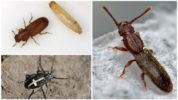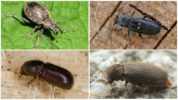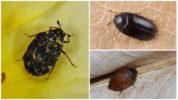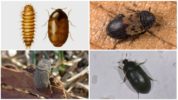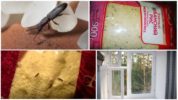- What are the "tenants"
- Mukoedy
- Surinamese
- Ginger Mucoed
- Merchant beetle
- Weevils
- Grinders
- Furniture
- Brownie
- Kozheedy
- Museum leather-eater (Anthrenus museorum)
- Carpet bee-eater (Attagenus unicolor)
- Kozheed Smirnova (Attagenus smirnovi)
- Fur Coat Eater (Attagenus pellio)
- Ham Skin Eater (Dermestes lardarius)
- Spotted Skin Eater (Dermestes maculatus)
- Grain Skin Eater (Trogoderma granarium)
- Ways to appear in the apartment
- How to deal with bugs in the apartment
- Mukoedy
- Weevil and grinders
- Kozheedy: museum, carpet, Smirnova
- Skin-eaters: cereal, spotted, ham, fur coat
- The penetration of beetles into the apartment
Not a single apartment is insured against pest invasion. Particularly small insects crawl even through mosquito nets on the windows. Since the apartment is not airtight, there are still many other passages for small parasites. Small brown bugs in the apartment appear with enviable regularity. Most often these are skin-eaters. But there may also be furniture grinders or flour eaters.
What are the "tenants"
From the beetles in the house you can find Surinamese and red flour-eaters, furniture and house grinders and a lot of different leather-eaters. All beetles are brown in color with shades from light to very dark. To identify small brown bugs in the apartment with names and photos is not enough, descriptions are also required. Beetles are often similar in appearance, but differ in size and habits.
Mukoedy
They belong to polyphage beetles, that is, their menu is very diverse. In apartments you can find three types.
Surinamese
Beetle 3-3.5 mm long with a red-brown back. The pest is flat, very long, with a thin body. On pronotum characteristic longitudinal “ribs”.
Interesting!
The first copies were delivered from Suriname, hence the name. Distributed everywhere.
Prefers bakeries as a bottomless power source. But often, along with flour and cereals, it ends up in apartments, where it infects other supplies. Vital activity of bugs leads to increased humidity in products, which is why mold forms in cereals.
The maximum life of 3 years. Usual 6-10 months. The life cycle is 27-51 days at a temperature of 29-35 ° C.
During her life, the female lays 43-285 eggs. At an ideal temperature of 27-29 ° C, the larvae hatch after 3-5 days. The larva grows to 3 mm, has a yellow-white color and a brown head.
On a note!
Theoretically, Surinamese flour eaters fly, they have wings. In practice, they just crawl.
Ginger Mucoed
A light brown beetle is about 2 times smaller than the Surinamese "brother." In the apartment, the food supply, habitats and life cycle are similar to those of Surinamese mukoed. Distinctive feature gingerbread cookie - immobility.
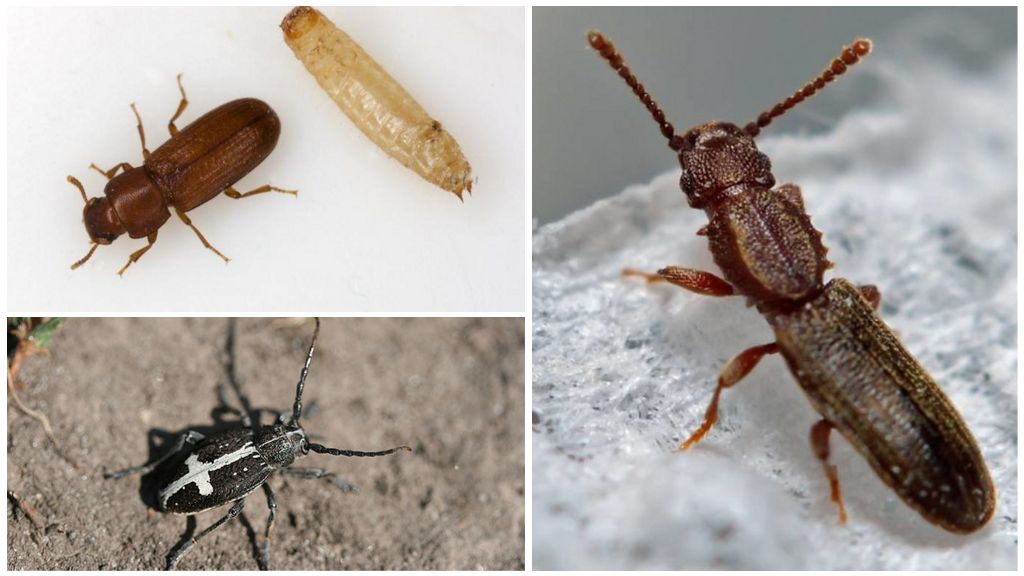
Merchant beetle
Flat small beetle 2.5 cm long. Almost completely identical to Surinamese in morphology and lifestyle, differing in eye size and head shape. Bugs are actively crawling, moving to new habitats.
Weevils
Other guests can enter the apartment along with the croup: small insects with an egg-shaped abdomen and a very long proboscis on their heads. The color of the bugs is dark brown or black. it barn or rice weevils. They feed on grain, preferring already fragmented seeds. The length of weevils is 2.3-3.5 mm. Larva is light yellow, up to 3 mm long. The head of the larva is short, no legs.
On a note!
Weevil It doesn’t fly, so it can only get into the apartment with spoiled groats from the store.
Grinders
If the ticking of the clock began to sound from the furniture side, this is a mechanical alarm clock that has not been forgotten somewhere. Wound up in furniture beetles grinders. The sound of the "hours of death" produces the larvae of insects that feed on wood. The apartment may appear 2 types of grinders: furniture and brownie.
Furniture
Small brown bugs on a windowsill made of wood may turn out to be furniture grinderswho left their shelters in wood. The size of the imago is 2.7-4.5 mm. The body is cylindrical, elongated. Elytra 10 clearly visible grooves. The body is covered with rare light bristles.
The imago lives only 6-28 days. In the adult state, the bugs do not feed, their only goal is to leave offspring. The wood is eaten by larvae that gnaw through passages in it and pupate there.
On a note!
The beetles' years are in May - June, and at this time you should be especially careful about the small brown bugs in the apartment.
Brownie
This bug is unlikely to appear in the apartment, because it prefers frost-damaged wood. But residents of wooden private houses should be wary of him. Compared to other domestic parasites, this is a large insect: 4-7 mm. Coloring is dark gray with a brown tint. On the sides of the pronotum there are spots of golden bristles.
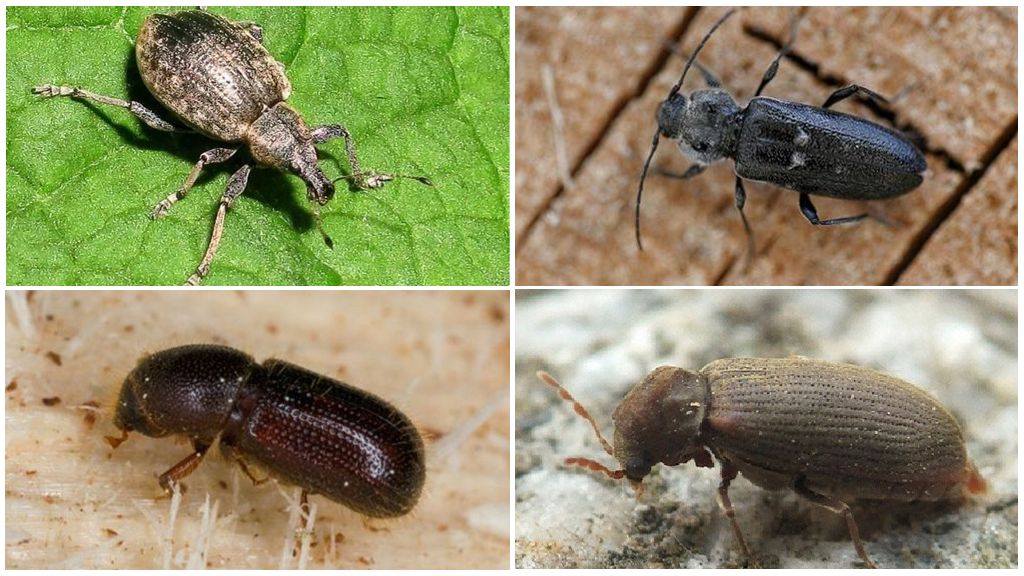
Kozheedy
The most numerous and unpleasant of the flat parasites of the winged wing detachment. They have a large feed base and they feed not only on skin, as you might think from the name, but also on various food products in the kitchen. The larvae of these brown domestic beetles are capable of damaging clothes made of wool no worse than moths. Among skin experts There are many synanthropic species that have already migrated to human housing:
- museum;
- carpeted;
- Smirnov's skin-beater;
- fur coat;
- ham;
- spotted;
- grain.
Bugs differ from each other in size and color, but they harm equally.
Museum leather-eater (Anthrenus museorum)
The second name is the museum bug. Black or brown beetle with white spots formed by light scales. Spots form a pattern of three “bandages”. The size of the bug is 2-3.5 mm. The insect is widespread in Eurasia and North America.
The museum is nicknamed for the fact that it often damages zoological collections. But there is no difference to a bug: he lives in a museum or in an apartment. Stuffed animals and books are not his main food. Larvae eat fur and wool, products of which can be found in any home. In nature, bugs are often found on flowering plants, and larvae on dried corpses of animals.
Carpet bee-eater (Attagenus unicolor)
Carpet beetle is distributed almost throughout the globe. It is absent only beyond the Arctic Circle and in South America. Under natural conditions, settles in the nests of birds that live in hollows. Having become a synanthropic species, expanded the menu and began to eat not only feathers, but also other foods:
- fur;
- wool;
- silk;
- flour;
- corn;
- other plant products.
The size of the bug is 2.5-5.5 mm. The body is oval. The color is uniform. Color options from light brown to black. This is a common synanthropic species of a skin-eater, and when small bugs appear in the house, you need to shake things and cereals in search of larvae.
The bug itself is harmless, its larvae harm.
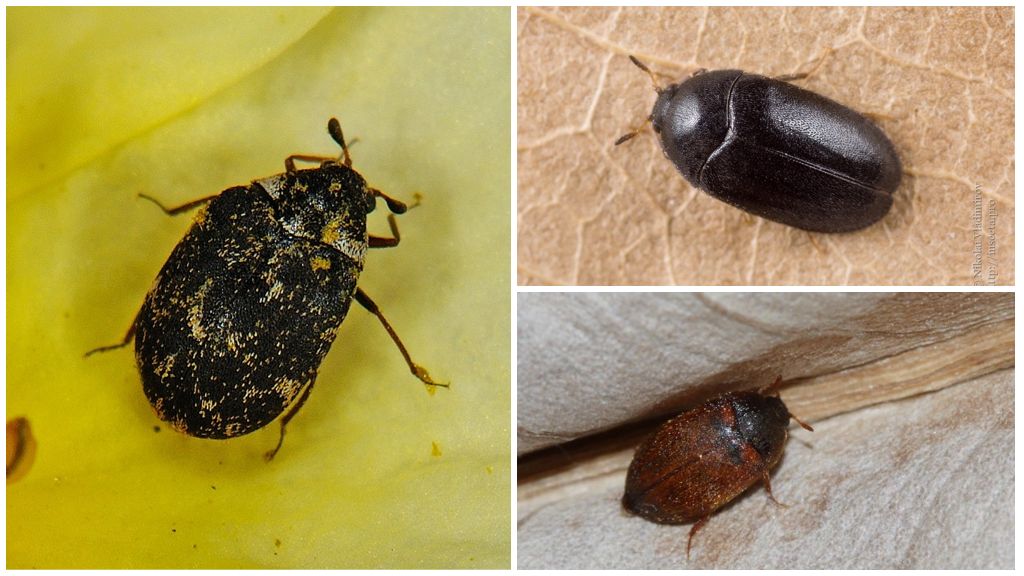
Kozheed Smirnova (Attagenus smirnovi)
The synanthropic species, together with humans, has spread throughout the world. The second name for this leather-eater is a brown fur bug. The body dimensions of the bug are smaller than those described above, and are 2.3-4 mm. The color of the pronotum and head varies from dark brown to black. Elytra covered with bristles and have a light brown color.
Larvae feed on:
- skin;
- furs;
- woolen products;
- carpets.
They are indifferent to food products.
Interesting!
Because of the Smirnov prefix in the UK, this skinneater is called the “vodka beetle” by analogy with the Smirnoff vodka.
Fur Coat Eater (Attagenus pellio)
Another name is a fur leather-eater. Synanthropic type of bugs. The body is 4-6 mm long, oval. Pronotum and head black; elytra dark brown with sparse white sparse bristles. In apartments he lives in house dust, eating organic residues there. She doesn’t forget about clothes made of natural wool.
Ham Skin Eater (Dermestes lardarius)
The birthplace of this synanthropic species of skin-eaters is Eurasia. With man spread to other continents. The body size of the bug is very large for this group of insects: 7-10 mm.
The ham horseman is covered with thick bristles. On the pronotum, it is black with specks of yellow bristles. On elytra wide band in the upper part. The band is formed by yellowish-gray bristles. Elytra below dark brown color. Larvae of black-brown color, covered with bristles.
The skin eater’s larvae feed on almost any product, damaging sericulture, beekeeping and poultry farming. In nature, they are found in burrows and nests of animals and on their corpses. In the apartment, a hamskinner eats woolen and leather goods, furs and food in the kitchen.
Spotted Skin Eater (Dermestes maculatus)
Together with humans, this synanthropic species of the skin-eater spread throughout all the continents except Antarctica.
The size of the bug is 6-10 mm. The color is greenish brown. On the sides of the pronotum there is light bristle. Brown larvae are covered with red-brown bristles.
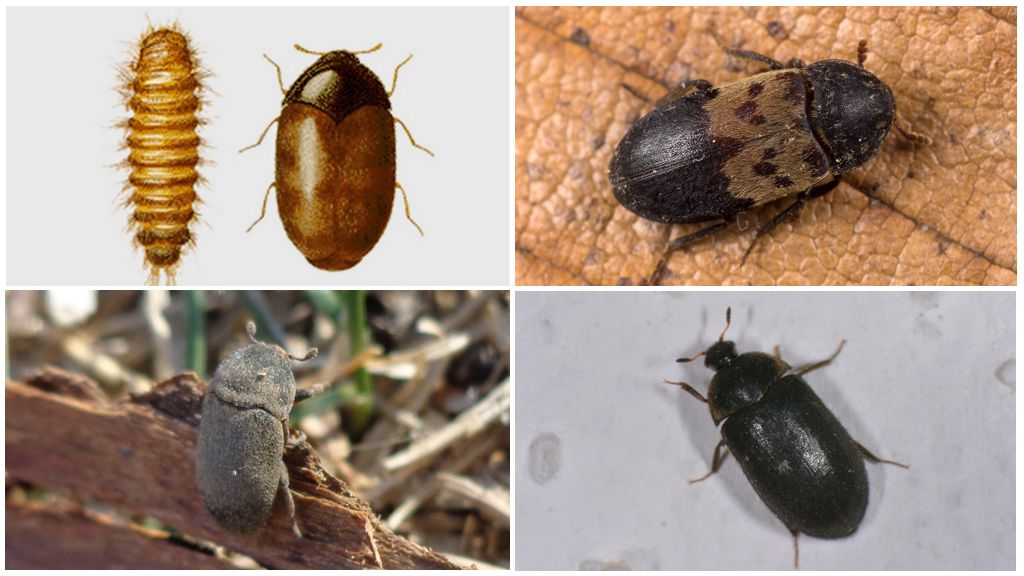
Interesting!
The most dangerous pest for animal products. The spotted skin eater is so specialized in animal proteins that it has cases of cannibalism: the larvae ate pupae. There have been cases when bugs attacked live turkeys and ate them alive.
Next to humans, this insect eats:
- skins;
- furs;
- smoked and dried fish;
- meat products;
- milk powder;
- cheese
- stuffed animals;
- silkworm cocoons.
Thanks to this addiction to animal food, criminologists use a spotted skin eater to determine the time of death of a person: adult individuals appear on corpses after 5-11 days.
Interesting!
Bugs are used in museums for high-quality cleaning of bones from the remnants of soft tissues.
Grain Skin Eater (Trogoderma granarium)
Another name is a kaprov bug. The birthplace of the insect is the tropical and subtropical zones of India. He has settled with a person almost all over the world and is a quarantine object in some countries. Very small bug covered with thick brown bristles. The length of the body of the skin tear is 2-3 mm. The body of the larvae with a length of 5 mm is covered with thick red-chestnut bristles.
At home, the leather-eater damaged copra and rice. With an increase in range, he expanded his feed base. Today it is a pest for peanuts, crops and other similar products. In the apartment he lives in cereals, flour and pasta.
Ways to appear in the apartment
There are two ways to get into an apartment with brown flying bugs:
- under its own power through a window or ventilation;
- in purchases from the store.
Grocery stores with unscrupulous personnel are especially dangerous in terms of introducing harmful insects. Most often they bring mukoedov from there, but in the same way, skin eaters can also get into the apartment with groats.
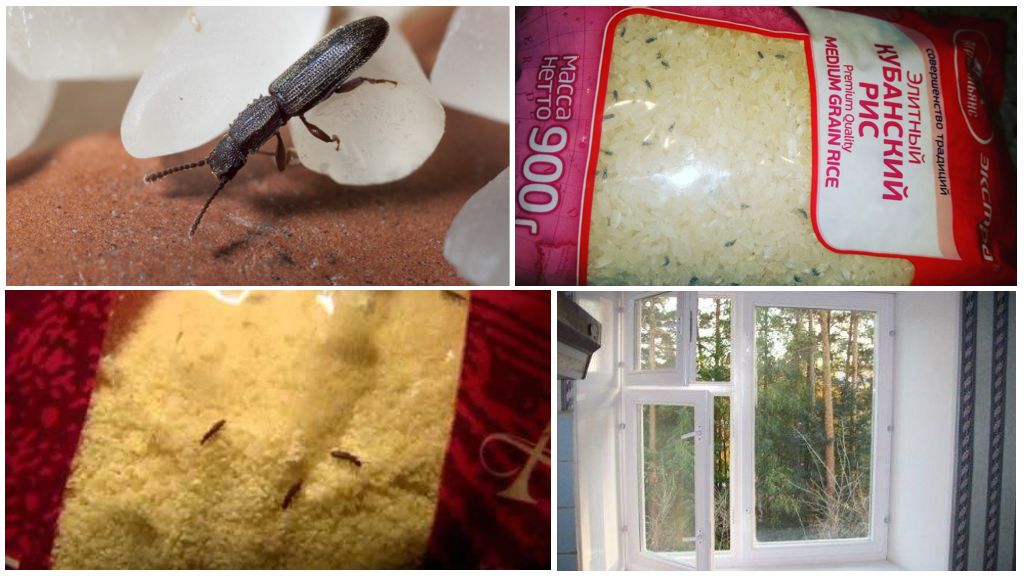
In the absence of mosquito nets on the windows, bugs can penetrate through the window, attracted by the smell of edible. But for especially small species of bugs, even the grid will not be an sufficient barrier, they will crawl through the cells.
On a note!
A skin-eaters getting into an apartment through a ventilation shaft is possible if the population has already bred from one of the neighbors.
How to deal with bugs in the apartment
If small brown beetles with wings appeared in the apartment, then you need to look for where the larvae breed. One skin-bearer accidentally flown into an apartment may be a "guest", several - already tenants. To get rid of small bugs in the apartment, you have to shake up the entire contents of the kitchen and wardrobes. And at the same time take a closer look at the furniture.Some leather-eaters do not disdain synthetics.
Spoiled cereals are thrown out. In the future, it must be stored in glass or metal containers. Review all clothes and carefully check the slots behind the skirting boards and ventilation holes. Carefully inspect carpets, especially rolled up.
After finding the main nest, spoiled things and products are thrown away. The whole apartment is thoroughly vacuumed. Immediately after cleaning, the dust bag is shaken out of the apartment. Well, if you can burn insects.
One cleaning will not be enough. This procedure should be carried out daily for at least a week. During this time, the number of bugs will decrease. But it will take a long time to control their appearance.
For preventive purposes, it is recommended to periodically ventilate and freeze household items.
For the furniture grinder, the methods of struggle are different: manual processing of the holes that the larvae made is holes 1-2 mm in size and you need to carefully examine the wooden parts of the furniture to find the larvae. Vaseline oil is pumped into the discovered holes from a syringe with a needle and mink is waxed with wax, paraffin or window putty. After 2 weeks, the operation is repeated. If no new holes appeared within a month, the larvae died and the new generation did not go free. But with a strong infection with the grinder, you will have to resort to chemical preparations.
